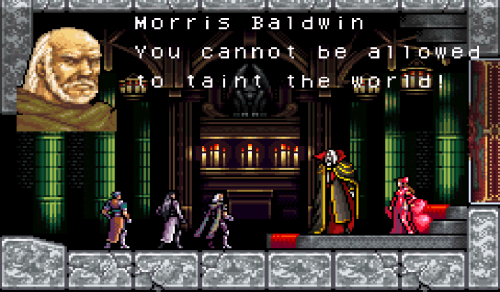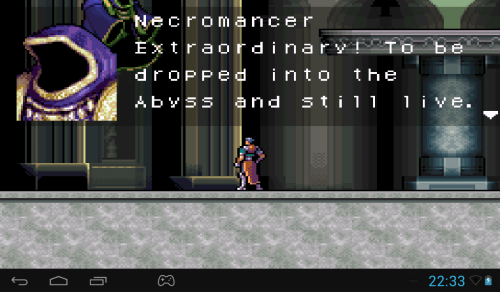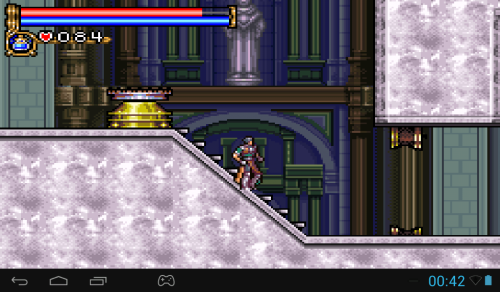Castlevania: Circle of the Moon is the first Castlevania game on the GameBoy Advance. I’ve never beaten it before, so I decided to give it a try. In this first posting, I’ll give you an overview of the game mechanics and features, since these vary a lot from game to game.
I’m a big fan of Castlevania games, but there’s a twist to it, one that’s probably common to many a Castlevania fan – I’m not a fan of the 3D ones, or the early ones. I love those Castlevania games that actually, properly belong to the 2D Metroidvania sub-genre. That being said, I only ever finished a few, so I decided to give Circle of the Moon a try, since it’s the first one of its kind on the GBA. Here’s the overview.
How it runs on Archos Gamepad
Quick answer: It runs amazingly well.
I’m using the GBA.EMU emulator and I’m able to map my physical buttons properly. I can even map a fast forward button, since I have room for extra controls, but there’s generally no need for fast-forwarding in a Castlevania game. I’ll keep it in mind for if and when I play Pokémon.

Pictured: The initial encounter with Dracula, before you wall through a hole that appears. You can revisit the room soon after, but it’s empty by then.
As I said, the game runs nicely. You can hide the Android status bar and, since the GBA screen had a slightly wider aspect ratio, you can stretch the visuals across the entire screen, without it looking too morphed.
It really is a very nice game to play on the Archos.
The Plot
It’s 1830…
In an old Austrian castle, from the worshipers of chaos, rise the plea for the return of the Lord of Darkness.
Circle of the Moon goes in medias res with the story. You start out at Dracula’s throne room and your master is a vampire hunter. Dracula collapses the floor below you and the master’s son, causing the two of you to fall to the dungeons below. As soon as you get there, the son shows what a spoiled and arrogant brat he is, leaving to save his father and telling you to go away because you’ll just get in the way.
That’s the plot. It goes further from that, of course, but that’s the entirety of the intro.
The mechanics
The core metroidvania mechanics – huge world, with areas and secrets being accessible after you acquire abilities is there. The first ability is the ability to dash, then there’s double jump, followed by the ability to charge and destroy blocks and some other stuff. Once you unlock abilities, you don’t have to actively equip them or anything of the sort. You’re just able to do the move.

Pictured: I’m gaining the Double ability, allowing me to double jump. It’s a reward for killing the first boss.
Of course, each Castlevania game of the metroidvania type also needs something special.
Firstly, you level up, but that’s expected.
Secondly, you can collect and equip gear. You have a slot for your armor and two slots for your hands (for wrist armor, bracelets, etc.). Even the most basic equipment makes a huge different in how much damage you deal and take, so it’s pretty important to upgrade as soon as you can. That being said, after the first few bosses, all I can tell is that equipment is mostly collected via random drops from enemies. They aren’t unique per enemy either. Groups of enemies share common drops.
The final and the biggest mechanic in Circle of the Moon is the Dual Set-up System. There are action and attribute cards that also randomly drop from enemies (though at least the first two dropped right at the start). You combine one card of each type to get a major effect. For instance, the Mercury action hard has the aspect of strength. Combining it with the Salamander attribute card gives you fire attacks with your whip (using mana with each attack), while a combination with the Mandragora card gives you plant-based whip attacks.
As I said, the cards seem to drop at random and certainly aren’t tied to any major enemies. One dropped from a Skeleton and another from an Axe Armor, I think. However, the first two dropped in the first room I had control over my character in. The third seemed to have dropped at random, but that part might also be fixed, just cleverly masked as random.
You can also acquire permanent stat-boosts and there’s a lot of them scattered throughout the castle. The three stats you upgrade this way are Health, Mana and Hearts.
While we’re on the subject of hearts, classical sub-weapons from the early Castlevania games are here and perfectly usable. I haven’t seen anything special about them – they seem to be the same ones from the early games, with expected nuance differences you’d expect.
Of course, there are also consumables that heal you, boost your mana or cure afflictions.
So, to put it in short, the mechanics of Castlevania: Circle of the Moon…
- Killing bosses unlocks abilities which give access to new parts of the castle.
- Level-up system.
- Armor (body, left and right hand) that drops randomly from enemies.
- Action and attribute cards which give you special powers when you combine one of each category. They also drop from enemies.
- Permanent health, magic and heart increasing items scattered throughout the castle.
- Sub-weapons that use hearts, just like in the classical Castlevania games.
- Consumables.
Flow of the game – how it plays
The controls in Castlevania: Circle of the Moon are stiff, but precise, kind of like in the old games. It takes some getting used to, but once you do get used to it, you can do wonders. The only thing I’m actually still having issue with is jump-attacking. From what I can tell, you can only swing your whip once while in mid-air, so it’s difficult to guess the correct moment to hit an enemy at a specific height. That’s my only problem, though.

Pictured: The second boss, Necromancer. He has two forms. I killed him by using the Cross sub-weapon.
Up to this point, I’ve killed two bosses, explored a big part of the area, collected probably at least four or five of each stat boost and upgraded my gear a few times. I have three movement abilities. Two were from the two bosses, but the first one was in a room with just a slightly tougher enemy, so a sort of mini-boss.
Before killing the second boss, my third card dropped – Mandragora. The first two cards dropped immediately at the start. Either cards really are random and quite rare, or two bosses are no indicator of how far into the game I’m progressing. It’s been ages since I last played Circle of the Moon. I remember getting quite far, but I don’t remember much about the details.
It feels like the fastest progression aspect of the game is the gear. It drops commonly, and each upgrade is very significant, making enemies that were a danger just a minute ago into a minor nuisance, both in how fast they die and how much damage they do to you.

Pictured: Teleporter rooms also have a unique look in each game. They serve as shortcuts throughout the castle.
The permanent stat boosts are possibly also significant, but the numbers aren’t right there on your screen, so you tend to not notice it as much.
The cards are cool, but apparently rare and I’m yet to see anything other than an elemental attack out of using them.
The world and the feel
Lot’s and lot’s of skeletons.
There are regular skeletons throwing bones at you. There are bomb skeletons throwing bombs at you. There are electrical and spear skeletons. Basically, many of the monsters that get different graphics and names in later games are now quite similar.
I’m far from being a Castlevania expert, but i feel it really shows that this is one of the early metroidvania style games. It takes a lot from the original games and it’s probably the closest to the original games any of the later Castlevania games has gotten to.

Pictured: Stepping on the platform has opened the door, opening a shortcut to an older area of the castle. These one-way locks are also a mechanism that limits initial exploration (in a good way).
I’m aware there’s Symphony of the Night on the PlayStation released four years earlier, but from what I can remember, that one was much more different. However, that one also had more of a nod to the old games with the characters and the unlockables, so there’s that.
Overall, Circle of the Moon feels difficult, but rewarding. Later games introduce some grinding, but I don’t feel the need to do so in this one. Equipment drops often enough and leveling isn’t significant enough to warrant it. Having a proper sub-weapon seems to be more important to defeating a boss, so that’s another nod to the older games.
Future
I’m actually thinking about playing through all the GBA and DS games, possibly Symphony of the Night as well, and then do a comparison, just to see how these games work against each other. I can’t make any promises, though. We’ll see what happens.
For now, I’d just like to beat this one, and I’d like to do it legitimately, without any re-winding or save states, like I used to do when emulating these games as a younger me. The difficulty and skill requirements seem rewarding enough to be worth it.











